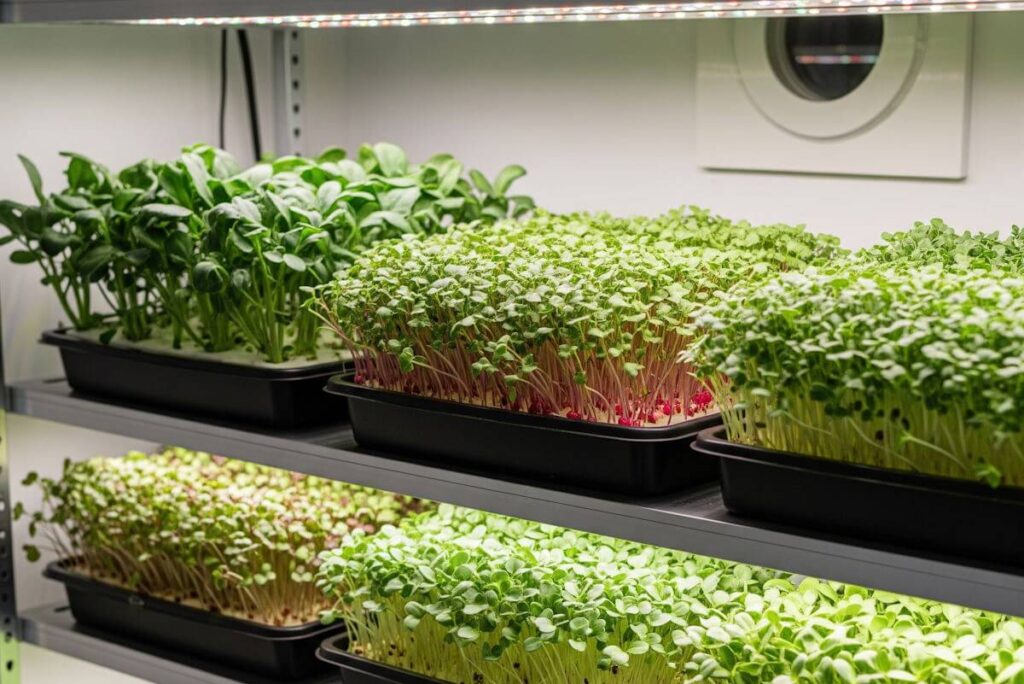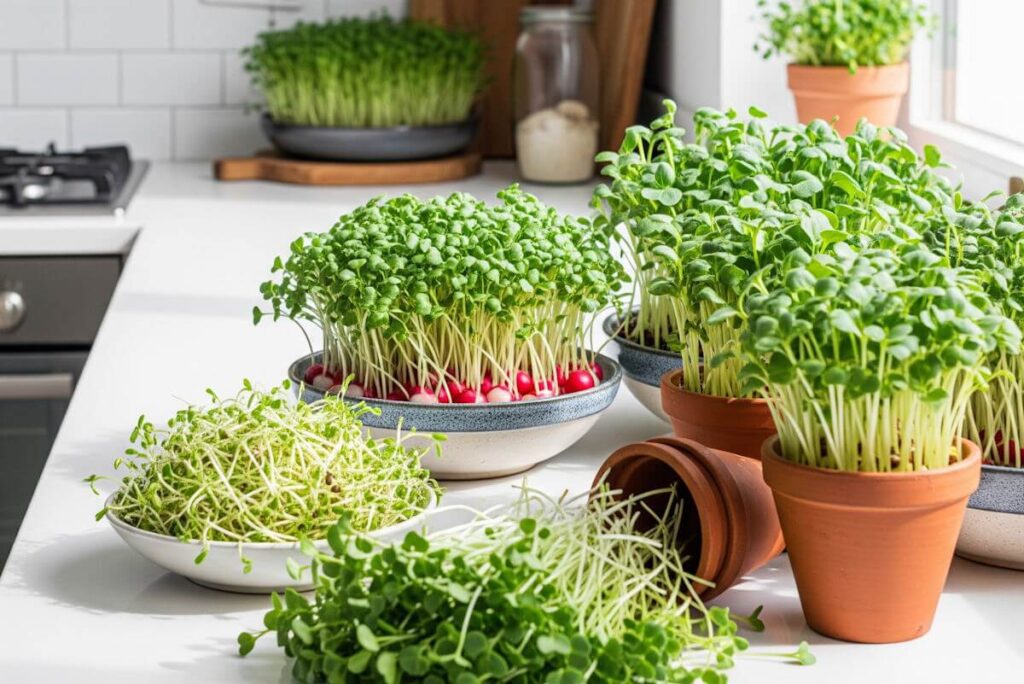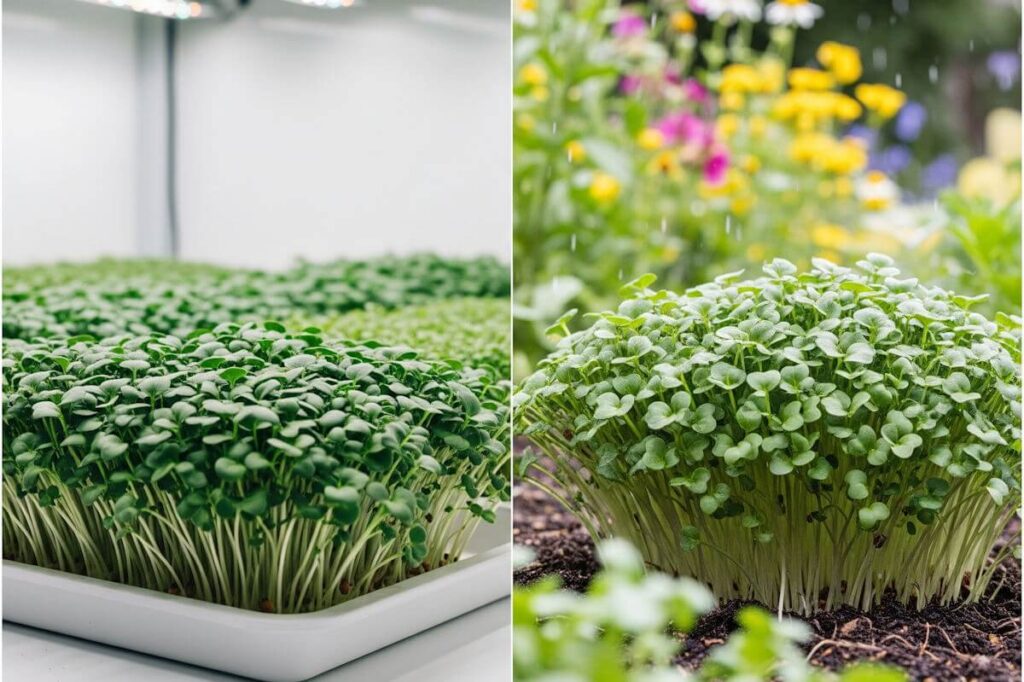Microgreens are young, edible plants harvested at the early stage of growth, typically within 7 to 21 days after germination. These delicate and vibrant greens are often used as garnish in dishes or added for their intense flavors and nutritional profiles. Common varieties of microgreens include arugula, radish, basil, and cilantro, each offering unique textures and tastes that can elevate culinary experiences.
One of the primary reasons microgreens have gained popularity is their outstanding nutritional benefits. Research indicates that these tiny plants can contain up to 40 times more vitamins and minerals than their mature counterparts. For instance, microgreens are rich in vitamins C, E, and K, as well as essential minerals such as iron and zinc. This nutrient density not only appeals to health-conscious consumers but also enhances the appeal of dishes in restaurants, making them increasingly favored by chefs worldwide.
The rising demand for fresh, local produce has led many individuals and businesses to consider microgreens as a profitable venture. They can be cultivated indoors or outdoors, requiring minimal space and resources, which makes them accessible even for small-scale farmers or urban gardeners. Additionally, microgreens can be grown year-round, providing a steady supply for markets and restaurants regardless of the season. This flexibility, along with their short growth cycle, allows growers to generate quick returns on their investment.
As sustainability trends continue to influence consumer choices, microgreens often represent an eco-friendly alternative to larger, more resource-intensive crops. By incorporating these small but powerful plants into diets, consumers are not only enhancing their meals but also supporting sustainable farming practices. The intersection of health, flavor, and sustainability contributes to the increasing allure of microgreens, establishing them as a worthwhile endeavor for those looking to enter the agricultural market.
Understanding the Importance of Year-Round Cultivation
Year-round cultivation of microgreens presents numerous benefits for growers, directing attention to enhanced profitability and a sustainable business model. One significant advantage is the ability to tap into a continuous customer base by providing fresh produce regardless of seasonal fluctuations. Microgreens, with their rapid growth cycle of just 7 to 21 days, enable farmers to harvest multiple crops throughout the year, thereby maximizing yield and revenue. As consumers increasingly seek fresh, nutrient-dense foods, the demand for microgreens remains consistently high, which can translate into steady sales.
Besides meeting the demands of a broad customer base, cultivating microgreens year-round also stabilizes the supply chain. Traditional farming practices often experience disruptions due to weather conditions, which can deter production and lead to customer dissatisfaction. However, by employing controlled indoor environments or greenhouses, growers can mitigate the adverse effects of seasonality and ensure a reliable output of microgreens. This stability is not only appealing to retail buyers, but it also encourages repeat purchases, thus fostering stronger relationships with customers.
The impact of seasonality on sales can be profound for those relying solely on seasonal crops. When certain varieties are unavailable, customers may turn to competitors, leading to lost business opportunities. In contrast, a commitment to year-round production allows growers to maintain their presence in the market and cultivate loyalty. Hence, the practice safeguards against potential declines in revenue associated with outside seasonal factors. By understanding the importance of consistent cultivation, microgreens producers can position themselves as dependable sources of fresh, high-quality products throughout the calendar year, achieving a sustainable competitive advantage.
Top Microgreens for Year-Round Growth
Microgreens are increasingly recognized for their nutritional value and culinary versatility, making them a favored choice among producers. Cultivating microgreens year-round allows growers to tap into a continuous market demand. Below are some of the best microgreens that can thrive throughout the seasons.
One of the most popular microgreens is the arugula. This leafy green flourishes in a variety of conditions, preferring cooler temperatures but remaining adaptable throughout the year. Rich in flavor, arugula adds a peppery zest to salads and sandwiches. Its robust flavor and demand in restaurants ensure it remains a staple in the microgreens market.
Basil microgreens are another excellent option for year-round cultivation. These small greens thrive in warmer environments and are valued for their aromatic qualities. The sweet and mildly spicy flavor of basil microgreens can enhance a wide range of dishes, from pizzas to pesto, making them highly sought after by chefs. Their popularity ensures steady sales throughout the seasons.
Pea shoots, known for their tender texture and sweet taste, are also ideal for year-round cultivation. They grow quickly in favorable conditions and are often used as a garnish or in salads. The increasing demand for fresh, local, and organic vegetables further bolsters the market for pea shoots.
Another exceptional variety is radish microgreens, notable for their spicy kick. They grow rapidly and can be harvested in about 10 days, making them perfect for quick returns on investment. Their distinctive flavor and ability to adapt to various growing conditions contribute to their high market demand.
Considering these options, growers can benefit from a diversified offering of microgreens that cater to consumer preferences and market trends throughout the year, ensuring steady sales and satisfied customers.
Optimal Growing Conditions for Microgreens
Microgreens are a popular choice for both home gardeners and commercial growers due to their rapid growth cycle and high nutritional value. To achieve successful cultivation of these young plants, understanding the optimal growing conditions is essential. Key factors include light, temperature, moisture, and the choice of soil or growing medium.
Light is one of the most critical elements in microgreens cultivation. Ideally, microgreens should receive around 12 to 16 hours of light daily. This can be provided through natural sunlight or artificial grow lights. When using grow lights, it is advisable to position them about 2 to 4 inches above the plants, ensuring an even distribution of light. Inadequate lighting can result in weak and leggy plants, ultimately affecting the quality and yield of the crop.
Temperature also plays a significant role in the growth of microgreens. Most varieties thrive in a temperature range of 65°F to 70°F (18°C to 21°C) during the day, with a slight drop at night. Maintaining a consistent temperature helps in promoting uniform growth. Sudden fluctuations may hinder seed germination and lead to poor growth performance, so it is essential to monitor and control environmental factors accordingly.
Moisture levels are equally important, as microgreens require a well-balanced level of humidity. The growing medium should be kept evenly moist, but not waterlogged, to prevent the risk of fungal diseases. Frequent misting can help maintain the right humidity, especially in drier environments. Selecting the right soil or growing medium also impacts the growth of microgreens. Lightweight, well-draining mediums such as coconut coir, seed-starting mix, or specially formulated microgreens mixes are recommended for optimal results.
By ensuring the right combination of light, temperature, moisture, and a suitable growing medium, growers can increase their chances of achieving healthy, thriving microgreens year-round, ultimately leading to steady sales and customer satisfaction.
Pest Management in Microgreens
Microgreens, while resilient and nutritious, are susceptible to various pests and diseases that can hinder their growth and diminish quality. Recognizing common pests is vital for successful microgreen cultivation. Aphids, thrips, and spider mites are frequent intruders, often hiding beneath leaves and causing damage by sucking sap. Fungi such as downy mildew and powdery mildew may also afflict microgreens, particularly under overcrowded or poorly ventilated conditions. Identifying these threats early can greatly enhance the effectiveness of management strategies.
Implementing pest management strategies requires a focus on organic and sustainable practices. One effective technique involves promoting a balanced ecosystem by introducing beneficial insects—such as ladybugs and lacewings—that prey on harmful pests. Additionally, using insecticidal soaps or neem oil can provide a non-toxic means of managing pest populations without harming the plants or surrounding environment. Regularly monitoring the crops for signs of infestation can ensure pest problems are promptly addressed before they escalate.
Furthermore, proper sanitation practices can greatly reduce the likelihood of pest infestations. Ensuring that all tools, trays, and materials are cleaned and sanitized regularly can prevent the introduction of pests into the growing environment. Crop rotation is another effective strategy, allowing for the alteration of plant families in specific areas to disrupt pest life cycles.
Providing optimal growing conditions also plays a crucial role in pest management. Adequate spacing between microgreens enables good air circulation, preventing humidity levels that favor mold growth and pest development. Moreover, utilizing natural predators and organic solutions promotes a safe environment for both producers and consumers. By embracing these sustainable practices, growers can cultivate healthy microgreens year-round while responsibly managing pest-related challenges.
Harvesting and Post-Harvest Handling
Harvesting microgreens requires precision and timing to ensure that they possess the optimum flavor and nutritional value. The ideal time for harvesting typically falls between 7 to 21 days after germination, depending on the specific type of microgreen. Observing the cotyledons can provide crucial information; these are the first leaves that emerge, and they tend to be most vibrant and tender just before they unfold fully. To achieve the best taste profile, it is recommended to harvest microgreens during the morning hours when they are most hydrated.
When it comes to the actual harvesting technique, using a sharp pair of scissors or a knife is advisable. One should cut the microgreens just above the soil line, ensuring minimal disturbance to the roots. This method not only ensures that the delicate leaves are not crushed but also helps maintain their aesthetic appeal, which is important for market sales. It is essential to handle the microgreens gently throughout the process to avoid bruising, which could lead to a decline in quality.
Post-harvest handling is equally crucial for maintaining freshness and extending the shelf life of microgreens. After harvesting, rinse the microgreens gently in cold water to remove any soil or debris. Once cleaned, it is beneficial to spin them dry using a salad spinner or absorb excess moisture with a soft cloth. Packaging should occur promptly, using breathable containers that allow for airflow but provide some protection against damage. Storing microgreens in a refrigerator at temperatures between 32°F and 40°F is ideal, as this helps to slow down spoilage and keep them vibrant for longer periods.
Overall, employing the right harvesting techniques and post-harvest handling practices will ensure that microgreens remain fresh, appealing, and nutritious, ultimately contributing to steady sales throughout the year.
Effective Marketing Strategies for Microgreens
Developing effective marketing strategies for selling microgreens is essential for achieving steady sales. The first step is to identify target markets. Microgreens tend to appeal to health-conscious consumers, chefs, and restaurants that prioritize fresh, high-quality ingredients. Focus on local markets, as fresh produce often garners interest among community members seeking locally sourced foods. Farmers’ markets, grocery stores, and even subscriptions for home delivery can become valuable platforms to reach this audience.
Once the target market is defined, leveraging social media platforms provides an excellent avenue for promoting microgreens. Platforms such as Instagram and Facebook allow for visual storytelling, showcasing the vibrant colors and nutritional benefits associated with microgreens. Creating engaging content, such as recipe ideas or video tutorials demonstrating their use in everyday cooking, can enhance consumer interest. Additionally, consider collaborations with local influencers or food bloggers who can share their experiences with microgreens, expanding your reach within the community.
Another critical element in the marketing strategy is packaging. Appealing packaging can significantly influence consumer purchasing decisions. Utilize eco-friendly materials that convey sustainability, aligning with the values of many consumers today. Well-designed labels that highlight health benefits, freshness, and unique flavor profiles can significantly increase the product’s attractiveness. Furthermore, providing additional information about the origin of the microgreens and their specific uses can create a deeper connection with consumers.
Finally, consider hosting workshops or tasting events to provide potential customers an experiential understanding of microgreens. Educational campaigns that teach about the culinary uses and health benefits can foster a better appreciation for the product. Offering promotional discounts for first-time buyers can also encourage trial purchases, potentially leading to repeat customers in the long term. Implementing these strategies will help create a strong market presence for microgreens and boost sales throughout the year.
Potential Revenue and Pricing Strategies
The microgreens market has gained significant attention in recent years due to its health benefits and culinary versatility. As farmers and entrepreneurs consider entering this lucrative sector, understanding potential revenue and effective pricing strategies is crucial for long-term success. Microgreens, typically harvested within 7 to 21 days of germination, allow for multiple cropping cycles throughout the year, offering an appealing prospect for steady sales.
One potential revenue stream comes from direct sales to local restaurants, grocery stores, and farmers’ markets. Establishing relationships with these businesses can yield consistent income while also allowing for dynamic pricing strategies tailored to market demand. Market research indicates that the pricing of microgreens can vary significantly based on factors such as type, quality, and local competition. For instance, specialty varieties may command higher prices, particularly if they are organically grown, appealing to health-conscious consumers.
Competition also plays a vital role in determining pricing strategies. Farmers should assess the local market landscape, including both large distributors and other small-scale growers. If the competition is limited, producers may have the leverage to set higher prices due to the scarcity of supply. However, in a saturated market, it may be necessary to adopt competitive pricing strategies that entice buyers without undervaluing the product.
Additionally, diversification of microgreens can enhance revenue potential. By cultivating various species tailored to specific customer preferences, growers can not only meet the different demands but also optimize their pricing structures. For instance, offering mixed microgreen salad packs can appeal to a broader customer base and justify a premium price point. Equally, subscription models offering regular deliveries could ensure a steady stream of revenue.
In conclusion, understanding the financial aspects of growing microgreens is essential for maximizing revenue potential. By strategically pricing products based on market demand, competition, and consumer preferences, growers can navigate the microgreens market effectively while ensuring sustainable profitability.
Conclusion: The Future of Microgreens Farming
The microgreens industry has experienced significant growth in recent years, driven by an increasing consumer demand for fresh, nutritious produce. This trend reflects a broader shift towards sustainable agricultural practices and a heightened awareness of health and wellness among consumers. As we have explored throughout this blog post, specific varieties such as arugula, radish, and sunflower not only offer superior flavor but also present appealing nutritional profiles. Their ability to thrive year-round makes them particularly well-suited for controlled indoor environments, unlocking the potential for consistent sales and profit margins.
Moreover, the market dynamics indicate that the popularity of microgreens is likely to continue on an upward trajectory. Entrepreneurs and farmers interested in this venture should consider the growing preference for local sourcing. This inclination supports microgreens farming, as they can be easily cultivated in small spaces and accessed by urban markets. The efficient use of vertical farming techniques further allows growers to maximize yield with minimal environmental impact, addressing the sustainability criteria increasingly posed by consumers.
As advanced agricultural technology continues to innovate, such as hydroponics and automated growing systems, aspiring microgreens farmers can leverage these tools to enhance productivity and efficiency. Many successful microgreens operations have adopted subscription models and direct-to-consumer sales, fostering relationships with customers that enhance loyalty and encourage repeat business. Therefore, individuals contemplating entry into this field must pay attention to current trends and adapt their strategies to remain competitive.
In conclusion, starting or expanding a microgreens operation can prove to be a lucrative venture within the local food system. By embracing sustainable practices and trends, growers can benefit from steady sales while contributing positively to the health of their communities and the environment.




